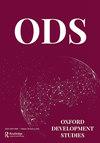拉美国家的外围性、收入不平等与经济发展
IF 1.2
Q3 DEVELOPMENT STUDIES
引用次数: 0
摘要
摘要:本文从新结构主义的视角出发,提出了拉美国家的一个发展难题:外部性(贸易条件波动加剧和技术落后)、收入不平等和人均收入之间的三角关系。我们采用一个联立方程模型,使用三阶段最小二乘(3SLS)来分析这种三角关系。我们发现,1995年至2014年间,14个拉美国家收入不平等的减少和人均收入的增加是相互促进的。尽管技术进步提高了人均收入,但它通过增加收入不平等在一定程度上缓解了这种增长。此外,外国技术来源,包括外国直接投资(FDI)对收入不平等的日益严重的影响在技术能力较高的国家得到缓解。虽然商品贸易条件的改善预期会增加南美国家的人均收入并减少收入不平等,但其波动性大多微不足道。本文章由计算机程序翻译,如有差异,请以英文原文为准。
Peripherality, income inequality, and economic development in Latin American countries
ABSTRACT Following a neo-structuralist perspective, this study presents a development puzzle for Latin American countries (LACs): a triangular relation amongst peripherality (increased terms-of-trade volatility and technological backwardness), income inequality, and per-capita income. We employ a simultaneous equation model using three-stage least squares (3SLS) to analyse this triangular relation. We find that a decrease in income inequality and an increase in per-capita income were mutually reinforcing in 14 LACs between 1995 and 2014. Although technological progress increases per-capita income, it partly mitigates this increase by increasing income inequality. Additionally, the increasing effects of foreign sources of technology, including foreign direct investment (FDI), on income inequality are mitigated in countries with higher technological capabilities. While an improvement in commodity terms-of-trade expectedly increases per-capita income and decreases income inequality in South American countries, their volatility is mostly insignificant.
求助全文
通过发布文献求助,成功后即可免费获取论文全文。
去求助
来源期刊

Oxford Development Studies
DEVELOPMENT STUDIES-
CiteScore
2.70
自引率
0.00%
发文量
20
期刊介绍:
Oxford Development Studies is a multidisciplinary academic journal aimed at the student, research and policy-making community, which provides a forum for rigorous and critical analysis of conventional theories and policy issues in all aspects of development, and aims to contribute to new approaches. It covers a number of disciplines related to development, including economics, history, politics, anthropology and sociology, and will publish quantitative papers as well as surveys of literature.
 求助内容:
求助内容: 应助结果提醒方式:
应助结果提醒方式:


